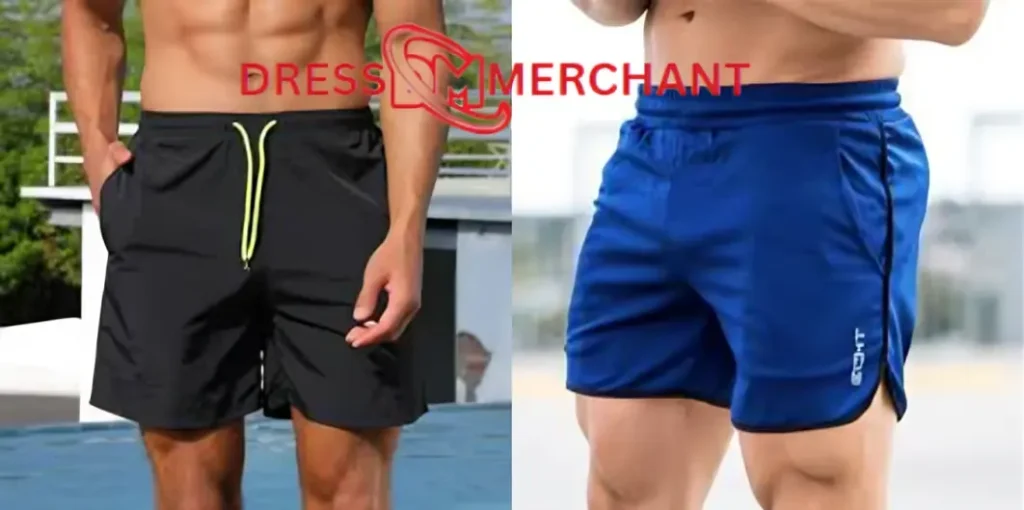Discover the Best Athletic Shorts For Summer with Dress Merchant – your trusted sourcing agent for premium apparel. We connect you to top-tier manufacturers and exporters specializing in high-performance, breathable athletic shorts ideal for warm weather. Whether you’re sourcing for retail or wholesale, Dress Merchant ensures unmatched quality, comfort, and style. Elevate your summer apparel line with expertly sourced activewear solutions.
Thank you for reading this post, don't forget to subscribe!1 The Essential Summer Wardrobe: Why Athletic Shorts Reign Supreme
Summer brings with it a universal desire for comfort, freedom of movement, and the ability to stay cool under the sun. In this seasonal shift, athletic shorts emerge not just as a choice but as an indispensable cornerstone of any practical and stylish wardrobe. Far transcending their initial purpose for sports, these garments have evolved into a versatile staple, capable of handling everything from intense workouts to casual outings, beach days, and even relaxed social gatherings.
The modern consumer demands attire that adapts to a dynamic lifestyle, blurring the lines between activewear and everyday comfort. This section explores the fundamental reasons why athletic shorts have become the quintessential summer garment, highlighting their unmatched blend of functionality, breathability, and aesthetic appeal that caters to a diverse range of activities and preferences during the warmer months.
1.1 The Ultimate Fusion of Comfort and Functionality
The primary appeal of athletic shorts lies in their unparalleled combination of comfort and functionality, a pairing that becomes especially critical in the heat of summer. Designed with movement in mind, these shorts typically feature lightweight, breathable fabrics that allow for optimal airflow, preventing overheating and discomfort during physical exertion or simply when temperatures soar.
The construction often includes features like elastic waistbands, adjustable drawstrings, and strategic seam placement, all contributing to an unrestrictive fit that moves with the body rather than against it. This functional design ensures that whether one is engaging in high-impact sports, a leisurely walk, or just enjoying a relaxed afternoon, athletic shorts provide the necessary freedom and ease. The thoughtful integration of these elements makes them superior to traditional casual shorts for active individuals seeking both performance and enduring comfort throughout the day.
1.2 Adapting to Diverse Summer Activities
One of the most compelling arguments for the dominance of athletic shorts in summer is their remarkable adaptability across a spectrum of activities. Unlike specialized garments, a well-chosen pair of athletic shorts can seamlessly transition from a morning run to an afternoon at the beach, followed by a casual evening barbecue. Their quick-drying properties make them ideal for water-related sports or unexpected summer showers, while their durable construction ensures they can withstand the rigors of outdoor adventures.
This versatility means fewer wardrobe changes and a more streamlined packing list for summer travel. For consumers, this translates to greater value and convenience, as a single pair can serve multiple purposes, reducing the need for numerous specialized items. Retailers recognizing this multi-purpose appeal can effectively market athletic shorts as the ultimate summer essential, capable of enhancing every aspect of a summer lifestyle.
1.3 The Growing Influence of Athleisure Trends
The sustained and expanding influence of athleisure has profoundly reshaped perceptions of athletic wear, elevating shorts from mere workout gear to fashion statements. This trend emphasizes integrating comfortable, performance-oriented clothing into everyday casual and even semi-formal ensembles. Athletic shorts, with their evolving designs, a broader range of colors, and improved aesthetics, have become central to this movement.
They are now regularly paired with stylish t-shirts, polo shirts, or even casual button-downs, accessorized with fashionable sneakers or slides. This cultural shift has normalized wearing athletic shorts in settings previously reserved for more conventional attire, such as cafes, public parks, or casual social gatherings. For brands and retailers, understanding and catering to the athleisure market means offering athletic shorts that not only perform well but also look good, aligning with contemporary style preferences and allowing consumers to effortlessly blend comfort with chic.
2 Decoding Fabric Choices: The Core of Summer Comfort
The material from which athletic shorts are constructed is arguably the most critical factor determining their suitability for summer wear. In the heat and humidity, fabric choice directly impacts breathability, moisture management, weight, and overall comfort. An expert understanding of different textile properties allows for informed decisions, ensuring that the shorts provide optimal performance and feel.
From advanced synthetics engineered for peak athletic output to natural fibers cherished for their softness, each material offers a unique set of benefits. This section delves into the various fabric options commonly used in athletic shorts, outlining their specific characteristics and highlighting why certain materials excel in summer conditions, empowering consumers and retailers to make the best selections.
2.1 The Prowess of Performance Synthetics
Performance synthetics, primarily polyester and nylon, are the workhorses of modern athletic shorts, especially for high-intensity summer activities. Their chemical structure makes them inherently lightweight, highly durable, and remarkably resistant to wrinkling and shrinking. Crucially, these fabrics excel in moisture management; they are hydrophobic, meaning they repel water and rapidly wick sweat away from the skin to the fabric’s outer surface, where it can quickly evaporate.
This keeps the wearer dry and comfortable even during strenuous workouts or in humid conditions. Many performance synthetics also incorporate anti-odor technologies, preventing microbial growth that causes unpleasant smells. For summer, their quick-drying property is invaluable, allowing for rapid recovery after a swim or a sweaty session. When blended with elastane (spandex), they offer exceptional stretch and freedom of movement, making them ideal for dynamic sports.
2.2 Embracing the Breathability of Natural Fibers
While synthetics dominate the performance realm, natural fibers, particularly cotton and its blends, hold a cherished place for their unparalleled softness and breathability, making them a popular choice for casual athletic shorts in summer. Cotton is known for its excellent absorbency, which can be a double-edged sword – it feels soft and allows air circulation, but can become heavy and slow to dry when saturated with sweat. However, for low-impact activities, lounging, or everyday wear in moderate summer heat, cotton’s comfort is unmatched.
Modern iterations often blend cotton with a small percentage of synthetic fibers like polyester or spandex to improve durability, reduce drying time, and add a touch of stretch. This hybrid approach aims to combine the natural comfort of cotton with some of the performance benefits of synthetics, offering a versatile option for those who prioritize a soft hand-feel for their summer athletic shorts.
2.3 Innovative Blends and Sustainable Materials
The frontier of athletic short fabrics is increasingly defined by innovative blends and a strong push towards sustainable materials. Manufacturers are constantly experimenting with combining different fibers to achieve a synergistic effect, merging the best properties of synthetics and natural fibers. For instance, blends of recycled polyester with Tencel or bamboo viscose offer moisture-wicking capabilities alongside a softer, more eco-conscious profile.
Recycled materials, such as recycled polyester derived from plastic bottles, reduce environmental impact while maintaining high performance standards. Similarly, sustainable alternatives like hemp, known for its durability and natural breathability, are gaining traction. These innovative fabrics often boast enhanced features like UV protection, advanced thermoregulation, or natural anti-bacterial properties. For summer, these cutting-edge materials provide superior comfort, performance, and peace of mind, appealing to environmentally conscious consumers seeking responsible yet high-performing athletic wear.
3 Understanding Length and Inseam: Finding the Perfect Fit
The length of athletic shorts, specifically their inseam measurement, is a crucial factor that profoundly impacts both comfort and style. What constitutes the “best” length is highly subjective, varying widely based on personal preference, the intended activity, and contemporary fashion trends. Too long, and shorts can feel restrictive or cumbersome; too short, and they might lack adequate coverage or feel inappropriate for certain settings.
For retailers and consumers alike, understanding the common inseam measurements and their implications for different body types and activities is key to selecting the ideal pair. This section will break down the popular inseam lengths available for athletic shorts, providing insights into their typical applications and aesthetic considerations for summer wear.
3.1 The Rise of Shorter Inseams (5-inch to 7-inch)
In recent years, there has been a significant resurgence in the popularity of shorter inseams for men’s athletic shorts, typically ranging from 5-inch to 7-inch. This trend is driven by a combination of fashion cyclicality and functional benefits. Shorter lengths offer maximum freedom of movement, making them ideal for high-impact activities like running, cross-training, or basketball where unrestricted leg motion is paramount.
They also provide superior ventilation, which is a major advantage in hot summer climates, helping to keep the wearer cooler. Aesthetically, shorter inseams create a more athletic and often more flattering silhouette for many body types, visually elongating the legs. They align well with current fashion sensibilities that favor more abbreviated styles. While once reserved primarily for performance, these lengths are now widely adopted for casual wear, reflecting a broader acceptance of comfortable and less restrictive attire.
3.2 The Versatility of Mid-Length Inseams (8-inch to 9-inch)
Mid-length inseams, typically falling between 8-inch and 9-inch, strike an excellent balance between coverage and freedom of movement, making them arguably the most versatile option for athletic shorts. These lengths usually hit just above or at the knee, offering enough coverage to feel comfortable in a variety of social settings without impeding athletic performance.
This makes them a go-to choice for general workouts, gym sessions, hiking, or simply as everyday casual wear. The 8-inch and 9-inch inseams are often considered universally flattering for most body types, providing a classic, proportionate look. Their adaptability means they are suitable for a wider range of activities and preferences, appealing to consumers who seek a single pair of shorts that can transition seamlessly from active pursuits to relaxed social environments without feeling too revealing or too restrictive.
3.3 The Classic Comfort of Longer Inseams (10-inch and Up)
While shorter styles have gained traction, longer inseams, typically 10-inch and above, continue to be a staple for those who prioritize maximum coverage, a more relaxed fit, or a traditional aesthetic. These shorts usually extend to or just below the knee. They are often favored for activities where modesty or sun protection is a concern, such as some team sports, light hiking in brush, or simply for individuals who prefer more fabric. Longer inseams can also be a comfortable choice for casual lounging or for those with taller frames who find shorter shorts too revealing.
While they might offer less ventilation than shorter styles, modern longer athletic shorts often incorporate side vents or wider leg openings to improve airflow. For retailers, offering a range of inseam lengths, including these classic longer options, ensures that every customer’s preference for coverage and comfort can be met, catering to a broader market segment.
4 Essential Design Features for Optimal Performance
Beyond fabric and fit, the specific design features integrated into athletic shorts play a pivotal role in their overall performance, functionality, and user experience. These seemingly minor details can significantly enhance comfort, convenience, and safety during summer activities. From innovative pocket solutions to strategic ventilation and thoughtful liners, each element is engineered to optimize the wearer’s experience.
For consumers, understanding the utility of these features helps in selecting shorts that truly meet their needs, while for retailers, recognizing their importance allows for curating a collection that genuinely stands out. This section will explore key design elements that elevate athletic shorts from basic garments to high-performing summer essentials.
4.1 Innovative Pocket Configurations and Security
The design and placement of pockets in athletic shorts are crucial for utility and can significantly impact their practicality. Traditional side pockets are convenient for casual use but can be impractical during intense activities, as items might bounce around or fall out. Modern athletic shorts often feature more innovative solutions. Zippered pockets, whether on the sides, back, or hidden within a seam, provide secure storage for essentials like keys, cards, or phones, preventing loss during dynamic movement.
Some designs incorporate dedicated phone pockets, often lined with moisture-wicking material, strategically placed to minimize bounce. Hidden stash pockets within the waistband or liner offer discreet storage for small valuables. For summer activities, quick-drain mesh pockets for water sports or internal key loops are also valuable additions. The thoughtful integration of secure and accessible pocket configurations enhances the functionality of athletic shorts for a wide range of activities.
4.2 Strategic Ventilation and Breathability Panels
In summer, effective ventilation is paramount for comfort, and athletic shorts incorporate various design features to maximize airflow. Beyond the inherent breathability of the fabric, strategic placement of mesh panels is a common and highly effective method. These lightweight, perforated panels are typically located in high-heat zones such as the inner thighs, side seams, or across the back of the shorts, allowing for increased air circulation where it’s needed most.
Laser-cut perforations are another sophisticated technique, creating small, precisely placed holes in the fabric to enhance breathability without compromising the garment’s integrity or aesthetic. Additionally, side vents or split hems on the leg openings allow for greater freedom of movement and facilitate airflow, especially during activities like running. These intentional design choices ensure that heat can dissipate efficiently, keeping the wearer cooler and more comfortable during intense summer workouts or simply on hot days.
4.3 Integrated Liners and Their Benefits
Integrated liners are a defining feature of many athletic shorts, offering a host of benefits that enhance comfort, support, and modesty. The most common types include brief-style liners and compression-short liners. Brief liners provide basic modesty and support, acting like built-in underwear, which eliminates the need for an additional layer. This is particularly beneficial for running and other high-movement activities as it reduces chafing and provides light support.
Compression-short liners offer more substantial muscle support, reduce muscle vibration, and improve blood circulation, which can aid in performance and recovery. They also provide excellent moisture-wicking capabilities and prevent chafing over longer durations. For water sports, mesh liners facilitate quick drainage. The material of the liner, often a moisture-wicking synthetic blend, is crucial. Wholesalers and consumers should consider the type of liner and its material when selecting athletic shorts, as it significantly impacts comfort, support, and the overall functionality of the garment for specific summer activities.
4.4 Reflective Elements and Adjustable Waistbands
Beyond core functionality, features like reflective elements and well-designed adjustable waistbands contribute significantly to the safety and comfort of athletic shorts. Reflective details, often subtly integrated as logos, stripes, or piping, are crucial for visibility during early morning or late evening summer activities when light conditions are low. This enhances the wearer’s safety when running or cycling near roads.
An adjustable waistband, typically an elastic band with an internal or external drawstring, ensures a secure and customizable fit. A high-quality drawstring that stays tied and doesn’t fray is a mark of well-made shorts. Some designs incorporate wider waistbands for increased comfort and a smoother silhouette, while others might feature a non-slip grip inside the waistband to prevent the shorts from riding down during dynamic movements. These thoughtful design elements underscore a commitment to both performance and user well-being, making athletic shorts truly effective for summer pursuits.
5 Sizing and Fit: Achieving the Ideal Summer Silhouette
Achieving the perfect fit in athletic shorts is as much about comfort as it is about performance and style. Ill-fitting shorts can lead to discomfort, chafing, and hinder movement, detracting from the overall experience. The challenge in wholesale and retail lies in navigating diverse body shapes and ensuring that sizing is consistent and accurately represented.
Understanding how different fits – from relaxed to compression – impact the silhouette and functional utility is crucial. This section will delve into the intricacies of sizing athletic shorts, offering insights into common fit styles and providing guidance on how to ensure customers find their ideal summer silhouette for both active pursuits and casual wear.
5.1 Navigating Standard vs. Athletic Sizing
The apparel industry often presents a confusing landscape when it comes to sizing, and athletic shorts are no exception. While most brands adhere to general S, M, L, XL sizing, the specific measurements for waist, hip, and thigh circumference can vary significantly between “standard” casual wear and “athletic” fits. Athletic sizing often accounts for more muscular builds, offering more room in the thighs and seat while maintaining a snug waist.
For wholesale buyers, it’s paramount to not just rely on letter sizes but to thoroughly examine each manufacturer’s specific sizing chart, including inseam and outseam measurements. Encourage customers to measure themselves accurately and compare against these charts. Providing clear size guides, potentially with model measurements or fit descriptions (e.g., “fits true to size,” “runs slightly small”), can help bridge the gap between perceived size and actual garment dimensions, minimizing returns due to fit issues.
5.2 The Spectrum of Fits: Relaxed to Compression
Athletic shorts come in a spectrum of fits, each designed for different preferences and activities.
- Relaxed Fit: Offers generous room through the thigh and leg opening, prioritizing maximum comfort and airflow. Ideal for lounging, casual wear, or activities where unrestricted movement is key, like walking or light workouts.
- Regular Fit: A balanced option, providing a comfortable amount of room without being overly baggy. Suitable for a wide range of activities and everyday wear.
- Athletic/Performance Fit: Often tapered slightly through the leg to reduce excess fabric, but still offers ample room for movement. Designed to optimize performance by minimizing bulk while maintaining comfort during active pursuits.
- Slim Fit: Cut closer to the body throughout the thigh and leg opening, offering a more streamlined and modern aesthetic. While still allowing for movement, they are generally less baggy than regular or relaxed fits and are popular for both active and fashion-forward casual wear.
- Compression Fit: Designed to fit snugly against the skin, providing muscle support, reducing vibration, and improving blood flow. Often worn as a base layer or as stand-alone shorts for high-intensity activities. These are tight by design and should feel like a second skin without being overly restrictive or painful.
Understanding these distinctions allows consumers to choose shorts that match their desired comfort level and functional needs, while retailers can stock a variety to cater to diverse preferences.
5.3 The Importance of Waistband Design and Adjustability
The waistband of athletic shorts is a critical component for achieving a secure and comfortable fit. A well-designed waistband ensures the shorts stay in place during movement without digging into the skin. Most athletic shorts feature an elastic waistband, which provides flexibility and adaptability. The quality of this elastic is paramount; it should be robust enough to hold its shape over time and resist stretching out.
An integrated drawstring, either internal or external, allows for additional adjustment and a customized fit, crucial for securing the shorts during rigorous activity. Some higher-end shorts may feature wider waistbands for increased comfort and a smoother, more flattering silhouette, or include silicone grippers on the inner waistband to prevent slippage. For retailers, highlighting these waistband features in product descriptions can help customers understand the level of adjustability and comfort offered, guiding them toward the ideal pair for their specific needs.
6 Strategic Sourcing: Partnering for Premium Wholesale Athletic Shorts
The foundation of a successful retail business selling athletic shorts, particularly for the summer market, lies in strategic and reliable sourcing. Identifying and collaborating with wholesale suppliers who consistently deliver on quality, ethical production, and logistical efficiency is paramount.
A strong supplier relationship transcends mere transactions; it’s a partnership that ensures inventory meets customer expectations, maintains brand reputation, and supports sustained growth. This section will guide wholesale buyers through the essential considerations for selecting and nurturing relationships with suppliers, focusing on vetting standards, negotiation tactics, and the long-term benefits of a robust supply chain for premium athletic shorts.
6.1 Rigorous Vetting of Manufacturing and Quality Control
Before committing to any wholesale supplier, a rigorous vetting process of their manufacturing capabilities and quality control standards is non-negotiable. This involves more than just reviewing catalogs; it requires a deep dive into their operational practices. Request comprehensive information about their production facilities, including any certifications they hold (e.g., ISO, WRAP for ethical manufacturing). Crucially, demand samples of various athletic shorts styles. Inspect these samples meticulously for fabric consistency, stitching quality, seam durability, and accuracy of sizing.
Check for common flaws such as loose threads, uneven hems, or faulty drawstrings. Inquire about their quality assurance protocols at each stage of production, from raw material inspection to final product checks. A transparent supplier will be eager to provide this information and demonstrate their commitment to high standards, which directly translates to the quality of products you offer to your customers.
6.2 Navigating Minimum Order Quantities and Pricing Tiers
Understanding and negotiating Minimum Order Quantities (MOQs) and pricing tiers is a critical aspect of wholesale sourcing. MOQs can vary significantly between suppliers and product lines, impacting your inventory investment and storage needs. Smaller MOQs might offer flexibility for testing new styles, while larger MOQs often unlock more favorable per-unit pricing.
Be prepared to discuss your current and projected order volumes, as this can influence a supplier’s willingness to adjust MOQs or offer bulk discounts. Don’t be afraid to negotiate, particularly if you envision a long-term partnership or if your order volume is substantial. Inquire about tiered pricing structures, where the cost per unit decreases as the order quantity increases. Clarify all pricing components, including product cost, shipping fees, customs duties, and any other surcharges, to ensure a transparent financial agreement and avoid unexpected expenses.
6.3 Cultivating Sustainable Supplier Relationships
Building long-term, sustainable relationships with your wholesale suppliers is a strategic asset that goes beyond immediate transactions. Treat your suppliers as valued partners, fostering open communication, mutual respect, and trust. Promptly address any issues or concerns, providing constructive feedback when necessary. Share your market insights and sales forecasts to help them better anticipate your needs and manage their production schedule.
A strong relationship can lead to numerous benefits: preferential pricing, priority access to new product lines, more flexible payment terms, and quicker resolution of any supply chain challenges. Suppliers are more likely to go the extra mile for established and collaborative partners, ensuring consistent product availability and potentially offering exclusive designs or customization options. Investing in these relationships creates a stable and efficient supply chain, critical for sustained success in the competitive athletic shorts market.
6.4 Ethical Sourcing and Environmental Compliance
In an increasingly conscious market, a supplier’s commitment to ethical sourcing and environmental compliance is becoming as important as product quality and price. Wholesale buyers should inquire about a supplier’s labor practices, ensuring fair wages, safe working conditions, and no child labor. Look for certifications such as Fair Trade, SA8000, or BSCI, which indicate adherence to social responsibility standards. On the environmental front, ask about their waste management, water usage, and energy consumption. Are they using eco-friendly dyes or sustainable materials?
Do they have certifications like OEKO-TEX (ensuring no harmful substances) or GOTS (for organic textiles)? Partnering with ethically and environmentally responsible suppliers not only aligns with growing consumer values but also mitigates reputational risks for your business. Clearly communicating these efforts to your own customers can become a significant unique selling proposition, attracting a demographic that prioritizes responsible consumption, especially for popular summer items like athletic shorts.
7 Dynamic Marketing for Maximum Summer Impact
Once you’ve secured an exceptional inventory of wholesale athletic shorts, the next critical step is to implement a dynamic marketing strategy that effectively reaches and engages your target audience, culminating in robust sales during the peak summer season. Marketing athletic shorts requires a nuanced approach that highlights their versatility, comfort, and style, catering to a broad spectrum of activities and consumer lifestyles.
This section outlines key marketing tactics, from compelling visual storytelling to strategic digital outreach, designed to maximize visibility, create desire, and drive conversion in the competitive summer apparel market.
7.1 Crafting Engaging Product Narratives
Beyond merely listing features, compelling product narratives are essential to connect with customers on an emotional level and demonstrate value. For athletic shorts, this means weaving a story that highlights the lifestyle they enable. Instead of just saying “moisture-wicking fabric,” elaborate on “stay cool and dry during intense summer workouts.” Emphasize the freedom of movement for adventurous outdoor pursuits or the ultimate comfort for relaxed weekend getaways.
Use vivid, evocative language that paints a picture of the product in use: “Transition effortlessly from a sunrise run to a boardwalk brunch.” Incorporate keywords naturally for SEO, focusing on long-tail phrases consumers might use, such as “best breathable shorts for summer hiking” or “quick-dry athletic shorts for beach.” A well-crafted narrative doesn’t just inform; it inspires, making the customer envision themselves experiencing the benefits of the shorts.
7.2 Visual Storytelling Through Professional Photography and Video
In the highly visual world of e-commerce and social media, professional photography and videography are non-negotiable for marketing athletic shorts. High-quality visuals allow customers to virtually experience the product. Invest in diverse photoshoots showcasing the shorts in various summer scenarios: dynamic action shots during workouts, relaxed candid shots by the beach, and stylish casual wear in urban settings. Show different body types wearing the shorts to help customers visualize the fit. Close-up shots of fabric textures, waistband details, and pocket features are crucial to convey quality.
Short, engaging video clips demonstrating the stretch of the fabric, the functionality of pockets, or the overall drape of the shorts can be incredibly effective. Consider animated graphics that highlight key features. The goal is to create an aspirational yet authentic visual narrative that resonates with your target audience, building trust and desirability.
7.3 Targeted Digital Campaigns and Social Media Engagement
Leveraging digital advertising platforms and social media is paramount for reaching your specific customer segments for athletic shorts. Utilize platforms like Instagram, Facebook, TikTok, and Google Ads to create highly targeted campaigns. Segment your audience by interests (e.g., fitness enthusiasts, outdoor adventurers, casual fashion lovers), demographics, and online behavior.
Develop ad creatives that speak directly to these groups, using compelling visuals and calls to action. On social media, cultivate an engaging presence by sharing user-generated content, running contests, posting styling tips, and creating interactive polls. Collaborate with relevant micro-influencers or fitness personalities who embody your brand’s values, allowing them to showcase the shorts authentically to their followers. Beyond paid ads, organic social media engagement builds community and brand loyalty, crucial for sustained summer sales.
7.4 Content Marketing for Authority and Discovery
A robust content marketing strategy establishes your brand as an authority in summer athletic wear and significantly enhances organic discoverability. Create valuable, informative content that extends beyond product listings. This could include blog posts like “The Ultimate Guide to Summer Athletic Shorts: Styles, Fabrics & Features,” “How to Choose the Best Shorts for Your Summer Workout,” or “Styling Athletic Shorts for Every Occasion.” Develop detailed buyer’s guides, comparison articles, or “top 10 lists.” Integrate relevant keywords naturally throughout this content to improve your search engine rankings (SEO). Consider creating short “how-to” videos on styling or care tips.
By consistently providing valuable insights and answering common consumer questions, you attract organic traffic to your website, build trust, and position your brand as a go-to resource for athletic shorts, indirectly driving purchasing decisions.
8 Optimizing E-commerce Experience for Athletic Shorts
In the digital age, a seamless and user-friendly e-commerce experience is as crucial as the quality of the athletic shorts themselves. For wholesale businesses, this extends to providing retailers with intuitive platforms and comprehensive product information. For direct-to-consumer sales, every touchpoint, from website navigation to checkout, must be optimized to convert Browse visitors into loyal customers.
A well-designed e-commerce presence not only facilitates purchases but also builds brand credibility and fosters customer satisfaction. This section delves into the essential components of an optimized e-commerce experience tailored for selling athletic shorts, ensuring clarity, convenience, and conversion.
8.1 Intuitive Website Navigation and Search Functionality
The cornerstone of a successful e-commerce platform is intuitive navigation. For athletic shorts, this means organizing products logically, allowing customers to easily browse by style (e.g., “running shorts,” “gym shorts,” “lounging shorts”), length (e.g., “5-inch inseam,” “mid-length”), fabric (e.g., “quick-dry,” “cotton blend”), or even specific features (e.g., “zippered pockets,” “liner”). Clear categories and subcategories reduce friction for the user. A robust search function is equally vital, enabling customers to quickly find exactly what they’re looking for using keywords.
Implementing filters for size, color, brand, price range, and features further refines the search process. An optimized navigation and search experience minimizes bounce rates, keeps users engaged, and guides them efficiently towards their desired athletic shorts, ultimately improving conversion rates.
8.2 Detailed Product Pages and High-Quality Visuals
Each product page for athletic shorts must be a comprehensive sales tool. Beyond compelling descriptions (as discussed in marketing), include multiple high-resolution images from various angles, showcasing details like fabric texture, pocket construction, and waistband design. Show the shorts on diverse body types and in lifestyle contexts to help customers visualize the fit and versatility.
Provide accurate sizing charts with specific measurements (waist, inseam, thigh circumference), and ideally, guidance on how to measure. Include information on material composition, care instructions, and key features clearly. Customer reviews and ratings should be prominently displayed, as social proof is a powerful motivator. For wholesale platforms, offering downloadable product sheets and high-res image packs for retailers is a valuable addition, empowering them to effectively market the shorts on their own channels.
8.3 Seamless Mobile Responsiveness and Load Speed
Given that a significant portion of online shopping occurs on mobile devices, an e-commerce website for athletic shorts must be perfectly mobile-responsive. This means the layout, images, and text automatically adapt to different screen sizes, ensuring a consistent and pleasant user experience on smartphones and tablets. Crucially, page load speed is paramount. Slow-loading pages are a major deterrent for customers, leading to high abandonment rates.
Optimize images, minimize unnecessary code, and leverage content delivery networks (CDNs) to ensure quick loading times across all devices. A fast, fluid mobile experience is not just a convenience; it’s a necessity for converting on-the-go shoppers and for improving search engine rankings, as search engines prioritize mobile-friendly and fast-loading sites.
8.4 Streamlined Checkout Process and Customer Support
The checkout process is the final hurdle in the customer journey, and any friction here can lead to abandoned carts. For athletic shorts, ensure the checkout is streamlined and secure, requiring minimal steps. Offer multiple trusted payment options (credit cards, digital wallets like PayPal or Apple Pay). Clearly display shipping costs and estimated delivery times early in the process.
Provide guest checkout options in addition to account creation. Post-purchase, excellent customer support is key. This includes prompt order confirmations, shipping notifications with tracking numbers, and clear information on returns and exchanges. Easy access to customer service via live chat, email, or phone for any inquiries about sizing, orders, or product details builds trust and loyalty, turning first-time buyers of athletic shorts into repeat customers.
9 Pricing Strategies for Competitive Advantage
Setting the right price for your athletic shorts is a nuanced art that directly impacts profitability, market position, and perceived value. It requires a deep understanding of your costs, the competitive landscape, and your target audience’s willingness to pay. Pricing too high can deter potential customers, while pricing too low can undermine your brand’s quality perception and erode margins.
A well-considered pricing strategy for wholesale athletic shorts balances profitability with market competitiveness, ensuring sustained growth and a strong brand presence. This section explores various pricing approaches and considerations crucial for success in the dynamic summer athletic wear market.
9.1 Cost-Based Pricing and Margin Optimization
Cost-based pricing is a foundational strategy where the selling price is determined by adding a specific markup percentage to the total cost of producing or acquiring the athletic shorts. This involves calculating all direct costs (raw materials, manufacturing, labor, packaging, shipping, customs duties) and allocating relevant indirect costs (overhead, marketing, administrative expenses) per unit. Once the total cost is established, a desired profit margin is applied.
For example, if a pair of shorts costs $10 to acquire and prepare for sale, and you aim for a 40% gross margin, the wholesale price would be $16. While straightforward, the challenge lies in optimizing this margin. It must be sufficient to cover all operational costs, generate a healthy profit, and allow for future investment, while remaining competitive. Regular re-evaluation of costs and market conditions is essential to adjust margins and maintain profitability without pricing yourself out of the market.
9.2 Competitive Pricing and Market Positioning
Competitive pricing involves setting prices for your athletic shorts primarily based on what competitors are charging for similar products. This strategy necessitates thorough market research to identify direct and indirect competitors, analyze their pricing models, and understand their value propositions. It’s not simply about being the cheapest; it’s about positioning your product intelligently within the market.
If your athletic shorts boast superior quality, unique features, or sustainable sourcing, you might justify a premium price point. Conversely, if you offer a more basic, value-oriented product, competitive pricing might involve matching or slightly undercutting rivals. Tools for competitive analysis include monitoring competitor websites, reviewing pricing on major retail platforms, and even mystery shopping. This approach ensures your pricing is attractive to potential buyers, aligns with market expectations, and helps define your brand’s position as a budget-friendly option, a premium choice, or a balanced offering.
9.3 Value-Based Pricing and Brand Perception
Value-based pricing centers on the perceived value of your athletic shorts in the eyes of the customer, rather than solely on production cost or competitor prices. If your shorts offer exceptional comfort, innovative technology (e.g., advanced moisture-wicking, anti-odor properties), unique design aesthetics, or are backed by a strong brand story (e.g., ethical production, celebrity endorsement), these attributes contribute to a higher perceived value. Customers are often willing to pay more for products they believe deliver superior benefits or align with their personal values.
To implement this, you must effectively communicate these unique selling propositions through your marketing and branding. For wholesale athletic shorts, this means emphasizing the quality of materials, the precision of construction, or the unique functionality that justifies a higher price point. This strategy aims to capture more of the value you create, attracting customers who prioritize quality and benefits over the lowest price.
9.4 Dynamic Pricing and Promotional Models
Dynamic pricing involves adjusting prices in real-time or strategically based on fluctuating demand, inventory levels, seasonality, or promotional opportunities. While more complex for wholesale, it can be implemented through tiered pricing (e.g., lower per-unit cost for larger bulk orders), early-bird discounts for pre-season orders, or flash sales for surplus inventory. Promotional models are crucial for stimulating demand during the summer season.
This could include offering bundle deals (e.g., “buy 2 pairs, get 15% off”), seasonal discounts (e.g., “Summer Activewear Sale”), or loyalty program incentives for repeat buyers. For wholesale athletic shorts, consider offering special introductory pricing for new retailers or volume-based incentives. These strategies help manage inventory, attract new customers, incentivize larger purchases, and respond agilely to market changes, ensuring consistent sales flow throughout the summer months.
10 Trends and Future Directions in Athletic Shorts
The market for athletic shorts is constantly evolving, influenced by macro-trends in fashion, advancements in textile technology, and shifting consumer priorities. For wholesale businesses, staying ahead of these trends is not just about staying relevant; it’s about anticipating demand, innovating product offerings, and securing a competitive advantage. From the ongoing blurring of lines between activewear and everyday clothing to a heightened focus on sustainability and personalized comfort, understanding these future directions is crucial for strategic planning.
This section explores the key trends poised to shape the future of athletic shorts, providing insights for informed decision-making and long-term success in the summer apparel industry.
10.1 The Evolution of Athleisure into Everyday Lifestyle Wear
The athleisure trend, which seamlessly blends athletic wear with everyday fashion, is set to continue its profound impact, evolving further into what can be termed “everyday lifestyle wear.” This means athletic shorts will increasingly be designed not just for performance, but with an aesthetic versatility that makes them appropriate for a broader range of non-athletic settings. Expect more refined finishes, subtle branding, sophisticated color palettes, and elevated details that blur the lines between casual and smart-casual.
The focus will be on comfort without compromising style, allowing individuals to maintain a polished appearance while enjoying the relaxed feel of athletic wear. This trend will drive demand for shorts made from more luxurious, soft-touch fabrics that drape well, and designs that incorporate elements from traditional menswear. Wholesalers should prioritize styles that offer this enhanced versatility, appealing to consumers seeking a cohesive wardrobe that supports a dynamic and comfortable lifestyle.
10.2 Sustainability and Circular Economy Principles
The future of athletic shorts will be heavily influenced by sustainability and circular economy principles. As environmental consciousness grows, consumers will increasingly demand products that are ethically produced and have a minimal ecological footprint. This translates to a greater emphasis on athletic shorts made from recycled materials (e.g., recycled polyester from ocean plastics), organic fibers (e.g., organic cotton), and innovative bio-based fabrics (e.g., plant-derived nylons).
Beyond materials, manufacturing processes will need to be more transparent and sustainable, focusing on reduced water usage, non-toxic dyes, and fair labor practices. The concept of a circular economy, where products are designed for durability, repairability, and ultimately, recyclability or biodegradability at the end of their life, will become more prominent. Wholesalers who champion these practices and can provide clear, verifiable information about their supply chain will gain significant market trust and appeal to a rapidly growing segment of eco-conscious consumers.
10.3 Advancements in Smart Fabrics and Wearable Technology
The integration of smart fabrics and wearable technology represents a thrilling frontier for athletic shorts. While still nascent in widespread application, future athletic shorts may feature embedded sensors to monitor vital signs (heart rate, respiration), track performance metrics (stride length, speed), or even provide localized compression to aid recovery. Fabric innovations will continue to push boundaries, offering enhanced thermoregulation (actively cooling or warming), adaptive moisture management (wicking sweat only when needed), and self-cleaning or odor-neutralizing properties that last the lifetime of the garment.
Lightweight, ultra-durable materials with advanced stretch and recovery will become standard. For wholesalers, staying informed about these technological advancements will be crucial for identifying cutting-edge products that offer unique value propositions and cater to the performance-driven segment of the market, potentially opening up entirely new product categories for summer athletic wear.
Conclusion: Best Athletic Shorts For Summer
At Dress Merchant, we understand that summer demands apparel that delivers both comfort and performance—especially when it comes to athletic wear. The best athletic shorts for summer strike the perfect balance between breathability, moisture-wicking technology, stretchability, and modern design. Whether for high-intensity workouts, casual wear, or outdoor adventures, choosing the right shorts can enhance both comfort and confidence.
As a trusted apparel and garment sourcing agent, Dress Merchant partners with top-tier manufacturers and exporters to bring global buyers premium-quality athletic shorts tailored for summer needs. From sustainable fabrics to performance-focused designs, we ensure that every product meets international standards and market demands. Choose Dress Merchant as your sourcing partner and gain access to the most versatile and trend-forward athletic wear collections for the season.













